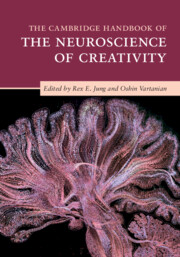23 results
14 - Biochemical Correlates of Intelligence
- from Part III - Neuroimaging Methods and Findings
-
-
- Book:
- The Cambridge Handbook of Intelligence and Cognitive Neuroscience
- Published online:
- 11 June 2021
- Print publication:
- 01 July 2021, pp 282-296
-
- Chapter
- Export citation
33 - A Look Back at Pioneering Theories of the Creative Brain
- from Part IV - Novel Combinatorial Forms of the Imagination
-
-
- Book:
- The Cambridge Handbook of the Imagination
- Published online:
- 26 May 2020
- Print publication:
- 18 June 2020, pp 548-562
-
- Chapter
- Export citation
Part V - Cognitive Control and Executive Functions
-
- Book:
- The Cambridge Handbook of the Neuroscience of Creativity
- Published online:
- 19 January 2018
- Print publication:
- 25 January 2018, pp 297-360
-
- Chapter
- Export citation
Part I - Fundamental Concepts
-
- Book:
- The Cambridge Handbook of the Neuroscience of Creativity
- Published online:
- 19 January 2018
- Print publication:
- 25 January 2018, pp 7-70
-
- Chapter
- Export citation
Acknowledgments
-
- Book:
- The Cambridge Handbook of the Neuroscience of Creativity
- Published online:
- 19 January 2018
- Print publication:
- 25 January 2018, pp xiv-xiv
-
- Chapter
- Export citation
Tables
-
- Book:
- The Cambridge Handbook of the Neuroscience of Creativity
- Published online:
- 19 January 2018
- Print publication:
- 25 January 2018, pp xi-xi
-
- Chapter
- Export citation
Contributors
-
- Book:
- The Cambridge Handbook of the Neuroscience of Creativity
- Published online:
- 19 January 2018
- Print publication:
- 25 January 2018, pp xii-xiii
-
- Chapter
- Export citation
Figures
-
- Book:
- The Cambridge Handbook of the Neuroscience of Creativity
- Published online:
- 19 January 2018
- Print publication:
- 25 January 2018, pp viii-x
-
- Chapter
- Export citation
Index
-
- Book:
- The Cambridge Handbook of the Neuroscience of Creativity
- Published online:
- 19 January 2018
- Print publication:
- 25 January 2018, pp 540-554
-
- Chapter
- Export citation
Part VII - Individual Differences
-
- Book:
- The Cambridge Handbook of the Neuroscience of Creativity
- Published online:
- 19 January 2018
- Print publication:
- 25 January 2018, pp 435-492
-
- Chapter
- Export citation
Part III - Attention and Imagination
-
- Book:
- The Cambridge Handbook of the Neuroscience of Creativity
- Published online:
- 19 January 2018
- Print publication:
- 25 January 2018, pp 159-230
-
- Chapter
- Export citation
Part VI - Reasoning and Intelligence
-
- Book:
- The Cambridge Handbook of the Neuroscience of Creativity
- Published online:
- 19 January 2018
- Print publication:
- 25 January 2018, pp 361-434
-
- Chapter
- Export citation
Introduction
-
-
- Book:
- The Cambridge Handbook of the Neuroscience of Creativity
- Published online:
- 19 January 2018
- Print publication:
- 25 January 2018, pp 1-6
-
- Chapter
- Export citation
Contents
-
- Book:
- The Cambridge Handbook of the Neuroscience of Creativity
- Published online:
- 19 January 2018
- Print publication:
- 25 January 2018, pp v-vii
-
- Chapter
- Export citation
Copyright page
-
- Book:
- The Cambridge Handbook of the Neuroscience of Creativity
- Published online:
- 19 January 2018
- Print publication:
- 25 January 2018, pp iv-iv
-
- Chapter
- Export citation
Part II - Pharmacology and Psychopathology
-
- Book:
- The Cambridge Handbook of the Neuroscience of Creativity
- Published online:
- 19 January 2018
- Print publication:
- 25 January 2018, pp 71-158
-
- Chapter
- Export citation
Part VIII - Artistic and Aesthetic Processes
-
- Book:
- The Cambridge Handbook of the Neuroscience of Creativity
- Published online:
- 19 January 2018
- Print publication:
- 25 January 2018, pp 493-539
-
- Chapter
- Export citation
Part IV - Memory and Language
-
- Book:
- The Cambridge Handbook of the Neuroscience of Creativity
- Published online:
- 19 January 2018
- Print publication:
- 25 January 2018, pp 231-296
-
- Chapter
- Export citation

The Cambridge Handbook of the Neuroscience of Creativity
-
- Published online:
- 19 January 2018
- Print publication:
- 25 January 2018
3 - Sweet Dreams Are Made of This
- from Part I - Process and Structure of the Creative Personality
-
-
- Book:
- The Cambridge Handbook of Creativity and Personality Research
- Published online:
- 19 May 2017
- Print publication:
- 06 March 2017, pp 28-43
-
- Chapter
- Export citation



